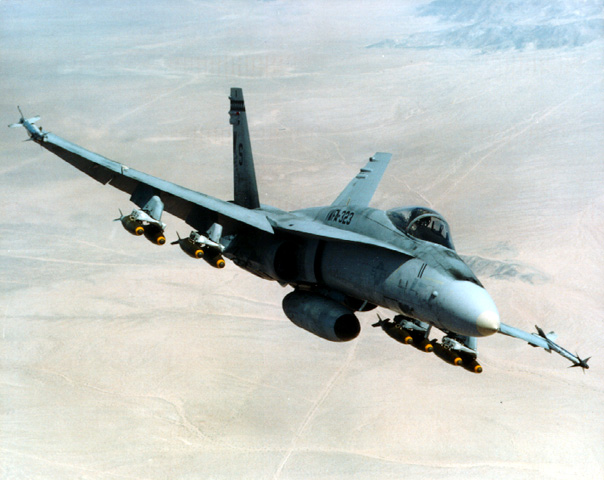

With a unit replacement cost of some $36.5 million (F/A-18C/D) and $41.6 million (F/A-18E/F), the F/A-18 Hornet has demonstrated itself to be one of the most cost-effective, safe, robust and efficient warplanes in military aviation history. With a sturdy time-tested 12,000-hour structural lifetime and more than three million flight hours (A/B/C/D-models combined) to its credit, the F/A-18 has proven three times more reliable and requiring half the maintenance of other fleet aircraft. In fact, during the Hornet's first 1.5 million flight hours, USN/USMC Hornet losses to accidents were 67, compared to 124 F-14s and 102 A-6s. In addition, the USN director of air warfare says Hornet squadrons cost some $1,000 less per hour to operate at about $17,200 per sortie (GAO figure).
The F/A-18 Hornet, the first tactical aircraft intended from inception for both air-to-air and air-to-ground missions, ultimately emerged as America's first strike fighter. It was designed for traditional strike applications such as interdiction without noteworthy degradation in fighter performance. In fact, the Hornet's excellent fighter and self-defense capabilities have given rise to the term "self-escorting striker". All Hornet configurations may be sea-based (carrier-borne) or land-based from prepared airfields, advanced bases or expeditionary airfields (EAFs).
The rather awkward and novel "F/A" prefix -- meaning combined "fighter" and "attack" -- became official in an April 1, 1984 DoD bulletin (however, McDonnell Douglas maintained its F-18 designation in all of its documents). As a multi-mission tactical aircraft, the F/A-18's primary functions are to attack and destroy surface targets, day or night, under all weather conditions; conduct multi-sensor imagery reconnaissance; engage and destroy enemy fighters and provide supporting arms coordination. In fighter mode, the F/A-18 is used primarily as an escort and fleet air defender. In attack mode, it is used for force projection and deep and close air support (CAS).
All F/A-18s can be configured quickly to perform either role and to accomplish specific mission types. This is accomplished through slight, but significant, modifications: through software means (in fact a single flip of a switch) and the selected use of other internal and external equipment. This "force multiplier" capability gives the operational commander more flexibility in employing tactical aircraft in a rapidly changing battle scenario.
The Marine Corps is the primary user of the F/A-18D, preferring the second crewman as a dedicated WSO. The USMC uses its F/A-18Ds as tactical striker, while the Navy considers them trainer aircraft. F/A-18Ds are deployed not only as strike-fighters, but also as airborne forward air controllers (FAC(A)), tactical air controllers (TAC(A)) and tactical reconnaissance aircraft.
Indeed, it is an aging aircraft. William Cohen, Secretary of Defense, rightly recognized in 1997 that the Hornet-C/D's with their current 1970s technology wouldn't cut it in a 21st century air combat zone. In addition to retrofits, upgrades and improvements on the existing Hornet airframe, procurement of a wholly new aircraft was considered paramount by the Navy. Enter the F/A-18E/F Super Hornet.
True, with the Hornet's combat role increasing, detractive sentiment may become more pronounced. Particularly in light of the 1997 retirement of the A-6 Intruder fleet, F/A-18s will be called upon to carry the bulk of USN strike tasking. Tomcats are being outfitted with LANTIRN FLIR pods and other air-to-ground enhancements for LGB-delivery capability from high and medium altitudes. These F-14 night-time precision improvements (likely to produce a new F/A-14 designation), will complement, but not entirely alter, the Hornet's strike predominance.
In addition, it will be early in the 21st century before sufficient numbers of Super Hornets enter service to alleviate the burden, still longer for the JSF and other advanced tactical fighters. Like it or not, ready or not, the Hornet will form the backbone of U.S. naval aviation for the foreseeable future.
Prime Contractor: McDonnell Douglas
Dimensions
Length: 17.08m
Height: 4.63m
Wingspan: 11.44m
Performance
Other Info
Please click here to go back to the HOME page.
Combat Ceiling: normally approximately 50,000 feet (15,250 m), though over 68,800 feet (21,000 m) has been attained.
Cruise Speed: 660 mph (1,062 km/h /574 kt); high subsonic to supersonic.
Maximum Speed (Clean at High Altitude): 1,190 mph (1,916 km/h) or Mach 1.8 at 40,000 feet with wingtip and fuselage air-to-air missiles.
Maximum Speed at Low Level: 812 mph (1,300 km/h)
Combat Radius (fighter mission)
Minimum Landing Roll: 2,800 ft (850 m), arrested this figure is some 650 ft (200 m)
Ferry Range: over 2,300 mi (2,000 nm or 3,700 km) without airborne refueling.
Climb Rate: 60,000 ft/min (18,287 m/min).
Survivable Descent Rate: 17 ft/sec (5.2 m/sec).
Minimum Speed (carrier landing): 131 kts.
Fuel Capacity: internal fuel is 1,670 gals (6,060 l) weighing 4,926 kg; plus optional drop tanks under fuselage and wings: